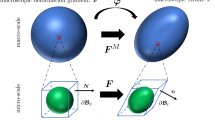Abstract
The homogenized behavior of a hyperelastic composite material is characterized by an effective stored-energy function that is functionally very different from the stored-energy functions that describe the underlying hyperelastic constituents. Over the past two decades, several analytical and computational results suggest that the case of isotropic incompressible Neo-Hookean composites in 2D may be the exception. This Note conjectures that the homogenized behavior of an isotropic hyperelastic solid made of incompressible Neo-Hookean materials is itself an incompressible Neo-Hookean material. To support this conjecture, earlier results are summarized, a new Reuss lower bound is derived, and a set of computational results is presented for the physically relevant cases of a Neo-Hookean matrix filled with random isotropic distributions of rigid and liquid circular particles of identical size.



Similar content being viewed by others
Notes
This is so even in the most specialized case of isotropic incompressible composite materials made of isotropic incompressible constituents, when the resulting effective stored-energy function \(\overline{W}(\overline{{\mathbf{F}}})\), much like the local stored-energy function \(W({\mathbf{X}},{\mathbf{F}})\), admits representations in terms of just \(N-1\) invariants.
Thanks to its objectivity \(\overline{W}({\mathbf{Q}}\overline{{\mathbf{F}}})=\overline{W}( \overline{{\mathbf{F}}})\) \(\forall {\mathbf{Q}}\in Orth^{+}\) and incompressibility \(\overline{W}(\overline{{\mathbf{F}}})=+\infty \) if \(\det \overline{{\mathbf{F}}}\neq 1\), the effective stored-energy function (3) admits representations in terms of two scalar variables, this regardless of its anisotropy. In this work, we found it convenient to use the representation \(\overline{\varPsi}(\lambda ,\varphi ):=\overline{W}(\overline{{\mathbf{F}}}_{ \varphi}(\lambda ))\), where \(\overline{{\mathbf{F}}}\) is given by (15) with \(\lambda \in \mathbb{R}\) and \(\varphi \in [0,\pi /2]\). In our calculations, we discretized the latter range as \(\varphi \in \{0,\pi /8,\pi /4,3\pi /8,\pi /2\}\).
References
Braides, A.: Homogenization of some almost periodic coercive functional. Accad. Naz. Sci. XL 103, 313–322 (1985)
Müller, S.: Homogenization of nonconvex integral functionals and cellular elastic materials. Arch. Ration. Mech. Anal. 99, 189–212 (1987)
Braides, A., Defranceschi, A.: Homogenization of Multiple Integrals. Springer, Berlin (1999)
Lopez-Pamies, O., Idiart, M.I.: Fiber-reinforced hyperelastic solids: a realizable homogenization constitutive theory. J. Eng. Math. 68, 57–83 (2010)
deBotton, G.: Transversely isotropic sequentially laminated composites in finite elasticity. J. Mech. Phys. Solids 53, 1334–1361 (2005)
Lopez-Pamies, O.: An exact result for the macroscopic response of particle-reinforced Neo-Hookean solids. J. Appl. Mech. 77, 021016 (2010)
Moraleda, J., Segurado, J., Llorca, J.: Finite deformation of incompressible fiber-reinforced elastomers: a computational micromechanics approach. J. Mech. Phys. Solids 57, 1596–1613 (2009)
Michel, J.C., Lopez-Pamies, O., Ponte Castañeda, P., Triantafyllidis, N.: Microscopic and macroscopic instabilities in finitely strained fiber-reinforced elastomers. J. Mech. Phys. Solids 58, 1776–1803 (2010)
Lefèvre, V., Danas, K., Lopez-Pamies, O.: A general result for the magnetoelastic response of isotropic suspensions of iron and ferrofluid particles in rubber, with applications to spherical and cylindrical specimens. J. Mech. Phys. Solids 107, 343–364 (2017)
Willis, J.R.: The overall elastic response of composite materials. J. Appl. Mech. 50, 1202–1209 (1983)
Kohn, R.V., Strang, G.: Optimal design and relaxation of variational problems, II. Commun. Pure Appl. Math. 39, 139–182 (1986)
Gusev, A.A.: Representative volume element size for elastic composites: a numerical study. J. Mech. Phys. Solids 45, 1449–1459 (1997)
Michel, J.C., Moulinec, H., Suquet, P.: Effective properties of composite materials with periodic microstructure: a computational approach. Comput. Methods Appl. Mech. Eng. 172, 109–143 (1999)
Lopez-Pamies, O., Goudarzi, T., Danas, K.: The nonlinear elastic response of suspensions of rigid inclusions in rubber: II — a simple explicit approximation for finite-concentration suspensions. J. Mech. Phys. Solids 61, 19–37 (2013)
Lubachevsky, B.D., Stillinger, F.H.: Geometric properties of random disk packings. J. Stat. Phys. 60, 561–583 (1990)
Geuzaine, C., Remacle, J-F.: Gmsh: a 3-D finite element mesh generator with built-in pre- and post-processing facilities. Int. J. Numer. Methods Eng. 79, 1309–1331 (2009)
Lefèvre, V., Lopez-Pamies, O.: Nonlinear electroelastic deformations of dielectric elastomer composites: II — non-Gaussian elastic dielectrics. J. Mech. Phys. Solids 99, 438–470 (2017)
Chi, H., Lopez-Pamies, O., Paulino, G.H.: A variational formulation with rigid-body constraints for finite elasticity: theory, finite element implementation, and applications. Comput. Mech. 57, 325–338 (2016)
Acknowledgements
Support for this work by the National Science Foundation through the Grant DMREF–1922371 is gratefully acknowledged. G.A.F. also acknowledges the support of the Simons Foundation. V.L. would like to acknowledge support through the computational resources and staff contributions provided for the Quest high performance computing facility at Northwestern University which is jointly supported by the Office of the Provost, the Office for Research, and Northwestern University Information Technology.
Author information
Authors and Affiliations
Corresponding author
Additional information
Publisher’s Note
Springer Nature remains neutral with regard to jurisdictional claims in published maps and institutional affiliations.
Rights and permissions
About this article
Cite this article
Lefèvre, V., Francfort, G.A. & Lopez-Pamies, O. The Curious Case of 2D Isotropic Incompressible Neo-Hookean Composites. J Elast 151, 177–186 (2022). https://doi.org/10.1007/s10659-022-09907-2
Received:
Accepted:
Published:
Issue Date:
DOI: https://doi.org/10.1007/s10659-022-09907-2




